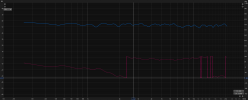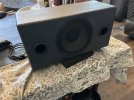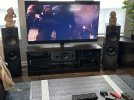- Joined
- Jan 15, 2022
- Messages
- 1,116
- Likes
- 1,400
- Thread Starter
- #21
LaVoce was kind enough to send me their FRD and ZMA files, so I was able to eat some FR curves for my baffle at a few different volumes.
LaVoce’s recommendation of 14.5 liters tuned to 90hZ using 4th order Butterworth crossover at 2200 hZ:

Some SpeakerSim’s auto calculate feature, 9.2 liters tune to 76 using the same crossover:

And 10.6 liters tuned to 88hz:

And just for fun, throwing it int to REW and generating an eq:

And with the crossovers and eq FIR filters +sub:

LaVoce’s recommendation of 14.5 liters tuned to 90hZ using 4th order Butterworth crossover at 2200 hZ:
Some SpeakerSim’s auto calculate feature, 9.2 liters tune to 76 using the same crossover:
And 10.6 liters tuned to 88hz:
And just for fun, throwing it int to REW and generating an eq:
And with the crossovers and eq FIR filters +sub:
Last edited:



